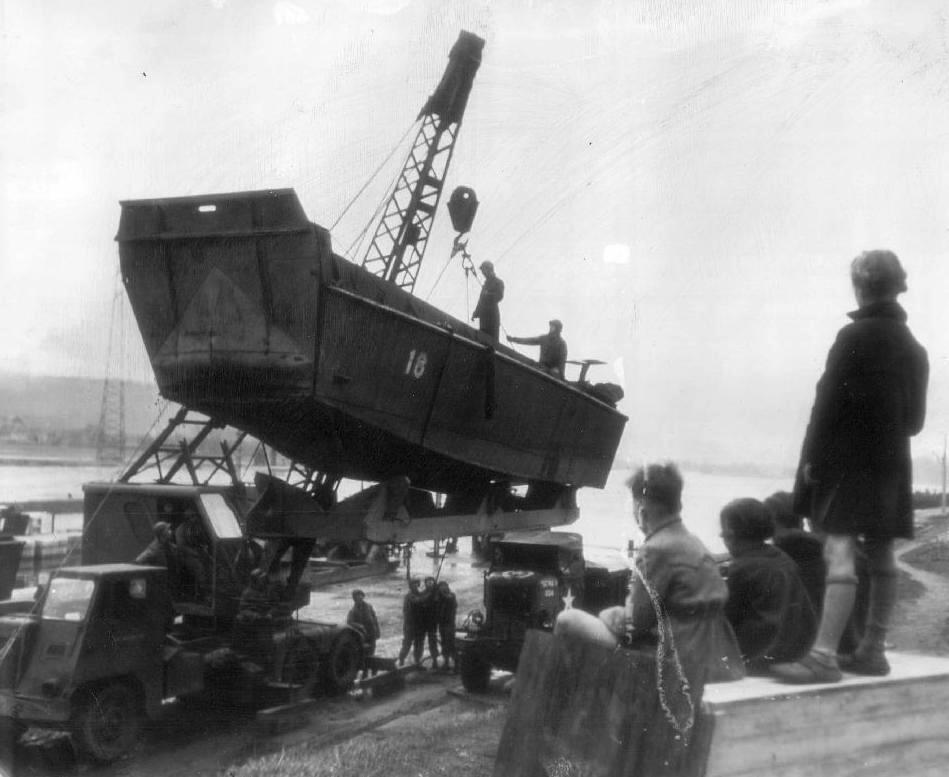
Western Allies: Build-ip in the West (January-March 1945)

Figure 1.--The United States created a huge supply infrastructure in the Normandy beaches and eventully the French and Belgian Channel ports through which supplies flowed through to reach the front which steadily moved east toward the Rhine. Here a Landing Craft, Vehicle, Personnel (LCVP) probably in Antwerp is being placed on a huge truck to be rushed to the Rhine which the Allies were preparung to cross. The photograph was taken approximarely March 15 about the same time that the Americans managed to capture the Remagen Bridge. The LCVP is better known as the Higgin Boat and was the primry landing craft used in the Nornmandy landings. The press caption read, "Landing craft loaded in truck--A group of Belgian children watch as United States Navy men load a LCVP in its craddle aboard a large Army truck for movement through Belgium to the banks of the Lower Rhine for use of Allied forces in full-scale crossings of that river yesterday. The photograph was made about two weeks ago in Belgium."
|
|
Supply problems forced the Allies to slow down their advance after liberating France (august 1944). As Allied armies grew in size and noved away from the invasion beaches the supply problem grew increasingly desperate. The French rail system had been wrecked to limit German usage and now it vould not be used by the Allies. The Red Ball Express was set up to use trucks to bring supplies forward, this helpe but did not deliver the supplies needed or a large-scale offensive. And the Germans understanding the importance of logistics had destroyed major ports or left garrisons to delay capture by the Americans. Thus thecallie hd to land supplies on beaches, a much slower operation than using develop port infrastructire. Miraculously Antwerp was captured in tack, but Montgomery failed to clear the Scheldt Estusry in a timely fashion so the port could be used. As a result, Eisenhower had to choose which commander to give the resources needed for an offenive. In part because of the V-2s, he chose Mongomery who had designed Market Garden to cross the Rhine in the Netherlands (October 1944). When Market Garden failed, the Allies had to limit operations, build up supplies, and prepare for a Spring offensive. The Whermacht emerged out of the rdennes mist (December 1944) to divide the Allies and seize Antwerp before the Allies solved their supply problem, The Bulge offensive proved to be onr of the lrgest and mot codtly bttles evdr fought by the U.S. Army. At the end of the battle, the Whermacht was finally fatally wrecked and no longer capable of offensive operation. It retired behind the Rhine and prepared a fixed defense of the Reich. Allied armies pushed forward in the Rhineland and northern France. And through all this the Allies gradually sloved their supply lines. The French ports and Antwerp began moving large quantities of supplies. The French rail system was partially repaired. Massive quantities of supplies flowed forward. Now every Allied Army was fully supplied and repolacements reached combat units fter the Bulge bloodletting. The British as a result of Ocean Garden were already on the Rhine. The American and now reformed French Armies rapidly approached the Rhine further south. Montgomery in the North began preparing a huge operation to cross the Rhine, virtually a second D-Day. The overall operation was Operation Plunder. Mongomery's massive part was Operatuion Varsity. Along with tanks, trucks, artillery and supplies moving toward the Rhine were ampphibious vehicles and landing craft. And the Americans now had the M-26 Pershing capable foir the first time of slugging it out with the few remining Mk.5 Panthers.
CIH -- WW II

Navigate the Children in History Website:
[Return to Converging Allied armies: The West page]
[Return to Main converging Allied armies page]
[Return to Main invasion of Germany page]
[Return to Main World War II Second phase campaign page]
[Biographies]
[Campaigns]
[Children]
[Countries]
[Deciding factors]
[Diplomacy]
[Geo-political crisis]
[Economics]
[Home front]
[Intelligence]
[Resistance]
[Race]
[Refugees]
[Technology]
[Bibliographies]
[Contributions]
[FAQs]
[Images]
[Links]
[Registration]
[Tools]
[Return to Main World War II page]
[Return to Main war essay page]
Created: 7:00 AM 8/18/2012
Last updated: 7:00 AM 8/18/2012



